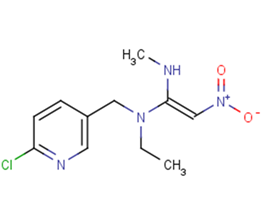
Nitenpyram
CAS No. 150824-47-8
Nitenpyram( —— )
Catalog No. M18057 CAS No. 150824-47-8
Nitenpyram is a nicotinic acetylcholine receptor (AchR) agonist, used as veterinary medicine to treat parasites of livestock and pets.
Purity : >98% (HPLC)
 COA
COA
 Datasheet
Datasheet
 HNMR
HNMR
 HPLC
HPLC
 MSDS
MSDS
 Handing Instructions
Handing Instructions
| Size | Price / USD | Stock | Quantity |
| 50MG | 29 | In Stock |


|
| 100MG | 39 | In Stock |


|
| 200MG | 61 | In Stock |


|
| 500MG | 119 | In Stock |


|
| 1G | Get Quote | In Stock |


|
Biological Information
-
Product NameNitenpyram
-
NoteResearch use only, not for human use.
-
Brief DescriptionNitenpyram is a nicotinic acetylcholine receptor (AchR) agonist, used as veterinary medicine to treat parasites of livestock and pets.
-
DescriptionNitenpyram is a nicotinic acetylcholine receptor (AchR) agonist, used as veterinary medicine to treat parasites of livestock and pets.
-
In Vitro——
-
In VivoNitenpyram is administered orally (1 mg/kg) for the short-term control of fleas in dogs and cats. Fleas start to fall from the animals 30 minutes post-administration and one dose can protect animals for 1-2 days.Since Nitenpyram is highly lipophilic, it is administered orally after the meal in order to induce bile flow to help dissolve the chemical, thereby increasing GI absorption of the drug. It is rapidly and completely absorbed from the GI tract in less than 90 minutes and is completely excreted in urine within 48 hours after oral administration to dogs and cats. Nitenpyram undergoes hydroxylation, followed by conjugation in the liver. The conjugates of Nitenpyram are excreted in the urine and Nitenpyram is not accumulated in body tissues. The plasma half-life of Nitenpyram in dogs and cats are 3 and 8 hours, respectively. It is likely that animals with liver and/or kidney problems may have longer plasma half-life of Nitenpyram.
-
Synonyms——
-
PathwayOthers
-
TargetOther Targets
-
RecptornAChR
-
Research AreaInfection
-
Indication——
Chemical Information
-
CAS Number150824-47-8
-
Formula Weight270.72
-
Molecular FormulaC11H15ClN4O2
-
Purity>98% (HPLC)
-
SolubilityIn Vitro:?DMSO : 125 mg/mL (461.73 mM)
-
SMILESCCN(CC1=CN=C(C=C1)Cl)/C(=C/[N+](=O)[O-])/NC
-
Chemical Name——
Shipping & Storage Information
-
Storage(-20℃)
-
ShippingWith Ice Pack
-
Stability≥ 2 years
Reference
1.Yan S, Wang J, Zhu L, Chen A, Wang J.Ecotoxicol Environ Saf. 2015 Dec;122:54-60.
molnova catalog



related products
-
Uridine
Uridine, Trisodium Salt is an energy-rich precursor in the enzymatic biosynthesis of RNA, a potent vasodilator, and induces contractile responses in some tissues.
-
H-HoArg-OH
H-HoArg-OH a homologue arginine is a strong inhibitor of human bone and liver alkaline phosphatase.
-
PROTAC-O4I2
PROTAC-O4I2, a PROTAC ligand targeting splicing factor 3B1 (SF3B1), induced FLAG-SF3B1 degradation in K562 cells with an IC50 value of 0.244 μM. PROTAC-O4I2 induced apoptosis in K562 WT cells.



 Cart
Cart
 sales@molnova.com
sales@molnova.com


